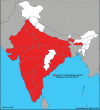Emerging & re-emerging infections in India: an overview
- PMID: 24056553
- PMCID: PMC3767269
Emerging & re-emerging infections in India: an overview
Abstract
The incidence of emerging infectious diseases in humans has increased within the recent past or threatens to increase in the near future. Over 30 new infectious agents have been detected worldwide in the last three decades; 60 per cent of these are of zoonotic origin. Developing countries such as India suffer disproportionately from the burden of infectious diseases given the confluence of existing environmental, socio-economic, and demographic factors. In the recent past, India has seen outbreaks of eight organisms of emerging and re-emerging diseases in various parts of the country, six of these are of zoonotic origin. Prevention and control of emerging infectious diseases will increasingly require the application of sophisticated epidemiologic and molecular biologic technologies, changes in human behaviour, a national policy on early detection of and rapid response to emerging infections and a plan of action. WHO has made several recommendations for national response mechanisms. Many of these are in various stages of implementation in India. However, for a country of size and population of India, the emerging infections remain a real and present danger. A meaningful response must approach the problem at the systems level. A comprehensive national strategy on infectious diseases cutting across all relevant sectors with emphasis on strengthened surveillance, rapid response, partnership building and research to guide public policy is needed.
Figures






References
-
- Bhatia R, Narain JP, Plianbangchang S. Emerging infectious diseases in East and South-East Asia. In: Detels R, Sullivan SG, Tan CC, editors. Public health in East and South-east Asia. Berkeley, USA: University of California Press; 2012. pp. 43–78.
-
- Fauci AS. Infectious diseases: considerations for the 21st century. Clin Infect Dis. 2001;32:675–85. - PubMed
-
- Combating emerging infectious diseases in the South-East Asia Region. New Delhi: World Health Organization, WHO SEARO; 2005. World Health Organization, Regional Office for South East Asia Region.
-
- Geneva: World Health Organization; 2003. [accessed on December 11, 2006]. Summary table of SARS cases by country, 1 November 2002 - 7 August. Available from: http://www.who.int/csr/sars/country/2003_08_15/en/index.html .
Publication types
MeSH terms
LinkOut - more resources
Full Text Sources
Miscellaneous
